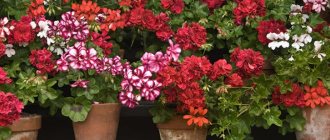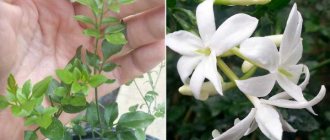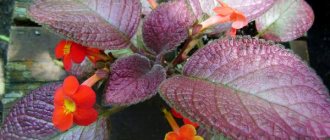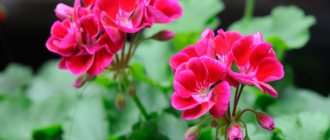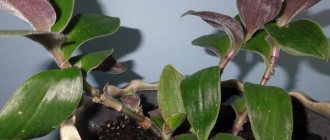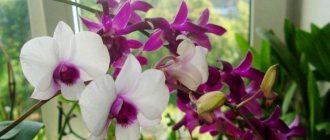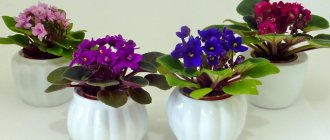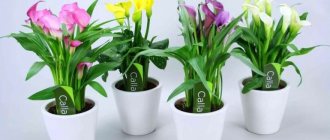Botanical description and history
Gloxinia has a second name “sinningia” . It originated in Brazil. There are more than 50 species of this plant. It is a tuberous plant. It is a perennial tropical shrub and herb. Stem erect, leaves and stem covered with hairs or glabrous.
ATTENTION : Gloxinia sonata has bright, velvety and single flowers. The corolla comes in a variety of colors, from white or purple to brown. It has four stamens and small seeds. Gloxinia is found on rocks, in the shade of a forest, near river banks.
Sinningia: diversity of species
Sinningia is a perennial herbaceous plant that forms rosettes of leaves planted on short petioles. The egg-shaped leaf blades have a dark green tint. The shape, size and color of the buds, depending on the variety, can be very diverse. There are plants with flowers in which the petals have a simple shape or corrugated edges, with buds pointing up or down. The color palette includes dozens of shades, starting with pinks and purples, ending with blues and purples. Interesting two-color buds, for example, red with a white border.
Flowers with a simple shape have a corolla that visually resembles a six-petaled bell, while hybrids created on their basis have semi-double and double lush inflorescences. The diameter of the blossoming buds varies from 2.5 cm to 10 cm.
Sinningia Pusilla
Sinningia Leucotricha
In nature, there are about 65 species of this culture. Most of them received official status only in 2012. Species synningias are interesting due to their variety of forms. Among them there are miniature beauties up to 2 cm high S. Pusilla, drought-resistant succulents S. Leucotricha, shade-tolerant exotics S. Reitzii...
In indoor floriculture, the most widespread species is Sinningia speciosa. Representatives of this species have spectacular buds of bizarre shapes and interesting colors.
Sinningia speciosa
Initially, this species was introduced into culture under the name Speciosa, better known as Gloxinia beautiful. The name was successfully assigned to the exotic. Today, many gardeners mistakenly call Speciosa by the name Gloxinia.
In fact, plants vary greatly:
- Sinningia has tuberous roots;
- Gloxinia - scaly rhizomes.
Today, hybrids of Sinningia beautiful are often found on sale, presented by manufacturers as grown from Gloxinia seeds. Plants created by breeders solely for the sake of gorgeous buds have a weak root system, and therefore die after a dormant period without recovering.
Representatives of the species Sinningia leucotricha - white-haired Sinningia - look no less interesting. All of them have large trunks that visually resemble balls. The diameter of the caudexes can reach 20 cm. During the growing season, fleshy stems of a light green hue appear on the above-ground thickening of the crop. The tops of the stems are decorated with leaves collected in rosettes. Due to this unusual structure, Sinningia white-haired is very reminiscent of a miniature palm tree. The main “highlight” of representatives of this species is the presence of felt pubescence. Soft white hairs cover the stems, leaves and even the buds of the plant.
Types of synningia
There are more than 30 species and hybrid varieties in the Sinningia genus. At home, the most common are the following:
Sinningia regal. The flower, about 10 cm high, consists of 4-6 pairs of densely pubescent dark green leaves. Lighter stripes are visible along the veins. Axillary flowers on drooping peduncles up to 20 cm long are purple. Flowering occurs in summer.
Sinningia regal
Sinningia is beautiful. The light green pubescent leaves are uniformly colored. Large tubular flowers are violet or purple in color with a lighter throat and lower petals.
Sinningia is beautiful
Sinningia Leukotricha (white-haired). The plant consists of 1-4 erect shoots 8-15 cm high. The bluish-green heart-shaped leaves are densely covered with elongated silvery hair. Their length is only 2-3 cm. A paniculate inflorescence with orange flowers blooms from the center of the leaf rosette. They have a long tube, but there is almost no bend in the petals.
Sinningia Leucotricha (white-haired)
Sinningia tiny is a dwarf variety. The height of the rosette is only 2.5 cm. Large bell-shaped flowers are located on top of the dark green leaves. The upper part of the petals is purple, and the lower part is white.
Sinningia tiny
The best varieties of exotic beauty
The number of hybrids and varieties of exotic beauty is so diverse that flower growers, to simplify the task, divided them into several groups. The key parameter is the shape of the flower. For example, the “Tidea” group combines varieties with corollas that have an expanded base and a concave apex. The Compact group includes small-sized plants, the diameter of whose leaves does not exceed an ordinary coin.
Depending on the size of the rosettes, synningias are divided into 4 groups:
- microminiature – up to 5 cm high;
- miniature – up to 12.5 cm high;
- compact – up to 20 cm high;
- standard – more than 20 cm.
Miniature and microminiature varieties are characterized by shortened stems of leaf blades. The annual growth of plants is achieved due to the appearance of new rows of leaves, which, like an umbrella, partially cover the previous ones. The ampel shapes look very interesting. Thus, the varieties “Deep purple” and “Tinkerbells” are advantageous in the sense that they are easy to form, quickly grow green mass and at the same time bloom continuously.
Sinningia Deep purple
The most decorative varieties are famous for:
- Treva's Treasure - bushes with medium-sized oval leaves and double tubular flowers. The pattern of petals, painted in light lavender color, is complemented by dark lilac-violet “strokes” and “rivulets”.
- Ozark First Born - has small ovoid leaves of a dark green color and large buds of a pink-violet hue, the petals of which are decorated with contrasting stripes and edging.
- Ugly Girl is a crop with small quilted leaves that form neat rosettes and graceful salmon-pink flowers. The buds are shaped like tiny jugs, the neck of which is decorated with a contrasting white and lilac pattern of dots and stripes.
- Krezdorn Yellow - bushes with small leaves, penetrated by a large number of glands, and medium-sized flowers, the petals of which are long narrow ribbons.
- Orange Zinger - plants with round green leaves forming a compact rosette and expressive tubular buds. The outer part of the petals is bright orange, while the inner part is a darker shade with crimson splashes.
- Amizade - bushes with pubescent dark green leaves and original tubular-shaped flowers. The outer side of the petals is painted purple, the inner “neck” is white, complemented by yellow stripes.
- Connect the Dots is a crop with dark green leaves with reddish veins and tubular white flowers richly decorated with purple-lilac specks.
Sinningia Ugly Girl
Sinningia Orange Zinger
Sinningia Lisa
Sinningia Texas Zebra
Sinningia Speciosa Pink
Sinningia Gabriel's Horn
A worthy competitor to the crops described above can be the variety "Lisa" with double white flowers with a wide crimson-pink border. The variety “Reitzii” with large scarlet flowers hanging in clusters above spreading leaves, “Texas Zebra” with lilac-pink buds decorated with intricate patterns, “Speciosa Pink” with large crimson flowers looks very interesting. The Gabriel's Horn variety has a special charm. It has a double corolla, in which the outer flower is wider and shorter than the inner one.
Types and varieties with photos
More than 30 species of Sinningia are known, including dwarf ones. Here are some of the most popular synnings.
Beautiful
Sinningia beautiful or beautiful (S. speciosa) - has light green, uniformly colored oval-shaped leaves. Tubular flowers with purple petals bloom in early spring.
Popular varieties:
- Fifiana;
- Emperor Frederik;
- Gregor Mendel.
Conspicua
Sinningia conspicua (S. Сonspicua) - a bell-shaped flower reaches a diameter of 5 cm. Its petals are colored beige, yellowish. Blooming flowers emit a pleasant lemon aroma.
Cardinal
Sinningia cardinalis (S. cardinalis) has white tubular buds.
Miniature Sinningia
Mini and microminiature varieties originate from other species that are small in their natural habitat. Here it is worth mentioning S. concinna with a rosette no more than 5 cm in diameter. From her the first miniature variety Cindy was bred.
Cindy
And tiny Sinningia (S. pusilla) became the source for most of the modern microminiature varieties.
Popular varieties of this species:
- Mont Blanc;
- Regina.
tiny
Mont Blanc
Regina
The miniature S. hirsuta and some others were also actively used in breeding work.
Khirsuta
Life cycle and dormant period of Gloxinia or Sinningia:
Sinningia or Gloxinia is a tuberous plant and therefore has a pronounced dormant period.
Autumn. Gloxinia is preparing to go into hibernation, flowering stops, the leaves on the plant begin to dry out, turn yellow and the roots begin to die. As soon as Gloxinia has begun the process of transitioning to a dormant period, it is necessary to gradually reduce watering. After all the foliage of the plant has died, it is necessary to cut the stem to a height of 1 cm above the soil level, and continue to add moisture to the pot from time to time.
Sinningia tubiflora.
Sinningia speciosa.
Winter. Sinningia has completely entered a dormant period; watering should be stopped completely. To store the tubers from the pot, you need to dig them up and place them over the winter. Store the tubers in a plastic container filled with slightly damp sand in a dark, cool place, for example, in a basement, garage or attic; if there is no suitable place, you can store it in a bright place, but then the container must be wrapped or covered with a thick layer of sand on top of the tubers. The ideal storage temperature is 10-14 °C. Watering during this period should be completely stopped, but in order to prevent the tubers from drying out, it is necessary to check their condition once a month and add a little moisture to the container.
Spring. When daylight hours begin to increase, the Sinningia tubers are cleaned of old dried roots, inspected for rot and, if necessary, cut off, treating the cut areas with crushed activated carbon. If the tuber is large enough and has a large number of shoots-stems, it can be divided, thus obtaining several more new specimens. For prevention, before planting, tubers can be soaked for half an hour in a solution of Fitosporin or another fungicide. After this, the tuber must be dried thoroughly. After this, you can plant in pots without deepening them too deeply, sprinkling the tops no more than 1 cm, otherwise only one shoot may grow, and others will not be able to hatch through the thickness of the earth. The soil is slightly moistened and covered with film, aired daily, and the pot is placed in a bright and warm place. The film is removed when the first shoots appear.
Sinningia cardinalis.
Reproduction
As you can see, this is a huge family. And how I want to breed many, many varieties! But how do these flowers reproduce? Sinningia or gloxinia are obtained from tubers, cuttings, lateral shoots or seeds.
Tuberous propagation is an easy method. To do this, the tuber from the mother plant is cut into several parts so that each fragment contains at least one stem. The cut areas are powdered with wood ash. After this, the fragments are planted in separate pots and the plants are cared for as usual.
With the cutting propagation method, a healthy leaf or stem tip is taken. It is cut off when the plant is flowering. To root the leaf, it is better to use waterlogged sand. To obtain a greenhouse effect, the leaf is covered with a glass jar. Then all that remains is to regularly moisten the sand and ventilate the leaf. When a tiny sprout appears, remove the jar. When the sprout grows, it is transplanted. Usually this moment occurs somewhere in one and a half to two months.
If a leaf or the top of a stem is rooted in water, this process will take at least three months. True, in this case you will see how first the roots are born, and then a small tuber. The appearance of a tuber is a signal that the sprout can be planted in a separate pot.
Sinningia is propagated using lateral shoots using the same technology as stem cuttings.
Seed propagation is not popular among home plant lovers. This method is used only by breeders or flower sellers. It should be understood that stores sell only those seeds that have inherited the maternal properties. Each package contains instructions on the rules of propagation from seeds. They must be strictly followed.
Problems of growing Sinningia
Brown spots on the leaves - formed if the plant was watered with cold water; the water for watering should be warm; if it is too cold, especially after watering.
The leaves turn yellow - from an overdose of fertilizers, when it is too dry and hot (above 30°C); when there is too much sun.
Gray plaque on leaves and flowers - gray rot or powdery mildew - fungal infections that usually occur when maintenance conditions are violated. It is necessary to stop spraying, remove the affected parts, and treat with a systemic fungicide.
Sinningia does not bloom - if it is not maintained correctly during the dormant period, when the tubers are very dry, they are kept warm; from excess nitrogen fertilizers, unsuitable soil rich in organic matter; with an acute lack of light (when the pot is not on the windowsill, but in a room without additional lighting); when it is very hot and the relative humidity is low.
Pests - Sinningia can be susceptible to attack by whiteflies, thrips, mealybugs and other pests (see pests).
Origin of Sinningia
This flower plant is native to Brazil. The main habitat of Sinningia is in the monsoon tropical forests of this country. A peculiarity of growth in such conditions is the alternation of rainy periods with dry ones, during which the plant plunges into a peculiar state of dormancy.
This plant was cultivated only at the beginning of the 19th century, when it became widespread among flower lovers and received the name gloxinia. However, this name later turned out to be erroneous. The correct name for this flower plant is Sinningia, and Gloxinia would be the correct name for various hybrids that differ in color and corolla.
Home care
Sinningia is easy to care for at home and unpretentious. Thanks to this, growing at home is accessible even to novice gardeners.
Lighting
Sinningia loves light, but is afraid of the scorching sun. East or west windows, or slightly shaded south windows are suitable for its placement. Particularly bright lighting is usually required for seedlings or saplings that are just forming a root system.
Temperature
In summer, the heat-loving Sinningia will be satisfied with a temperature of about 22-25 degrees. But after the dormant period has begun, the pot with the tuber must be moved to a dark and cool room, where the temperature remains no more than 12-15 degrees. Only such conditions will allow the flower to fully rest and gain strength before the new season.
Humidity level
The Sinningia flower prefers high humidity, but it should not be sprayed in the usual way. Moisture on the fluffy leaves and buds of the plant can leave stains on them. Instead of a sprayer, it is better to use open containers with water or place the flower on a tray with wet pebbles. You can keep the pot close to the aquarium.
Selection of capacity
The size of the pot for syningia directly depends on the size of its root system. Small tubers can be planted in small pots about 10 cm in diameter. Larger ones will also need an appropriate pot. But you shouldn’t immediately plant a small plant in a spacious container. In this case, all the strength of the tuber will be spent on the formation of leaves, and not on flowering.
Regularity of watering
Sinningia is a moisture-loving crop. It needs regular watering. However, it is not tolerant of moisture stagnation. Excessive dampness is detrimental to beauty tubers.
The key to successfully growing syningia at home is well-drained soil.
The frequency of watering is determined based on the degree of drying of the top layer of the earthen clod. To do this, you just need to note for yourself the day when the soil dries out, and, after waiting two days, water the plant again.
The fact that the soil has been saturated with moisture for a long time can be easily determined by the appearance of the bush. Its petioles and peduncles turn black, and the leaves become soft.
To water the crop, use only water that has settled for 24 hours at room temperature. Watering is carried out at the root of the plant, being careful not to wet the leaves and flower stalks.
In the autumn, when flowering ends and the dormant period begins, the number of waterings is reduced to a couple of times a month. By November, the plant almost completely fades. In winter, containers with roots are watered only once a month, avoiding waterlogging of the soil composition.
If the tubers of the plant are placed in sawdust or peat for the dormant period, there is no need for watering at all.
Feeding
Sinningia needs to be fertilized only during active growth - from April to October. For fertilizing, liquid formulations containing more potassium and phosphorus and less nitrogen should be used. They are applied once every 15-20 days.
Transfer
Small synningias grown from seeds or leaf cuttings will need several replantings per year. This is due to the active rate of their growth and tuber formation. Formed plants are moved to fresh soil less often - every spring.
When replanting, it is important not to bury the tuber completely in the soil. It should rise above ground level by at least one third.
Trimming
The shape of the synningia bush does not require pruning. Periodically, plants are simply cleaned of wilted leaves or flowers. In the fall, when the green part of the bush dries out, it is cut off, leaving only a small stump no larger than 2 cm in size.
Fertilizers
Fertilizing should be done throughout the growing season, as well as during the flowering of gloxinia. After flowering and during the dormant period, fertilizers are not applied. It is recommended to use mineral fertilizers.
Experienced gardeners advise using the following fertilizer scheme:
- Growing season – fertilize with nitrate fertilizer once every 10 days.
- Formation of buds - once every 10 days with potassium phosphate and superphosphate.
- Flowering period – 1 time in 10 days with potassium nitrate.
Do not overuse nitrogen. This can provoke active leaf growth and the development of small flowers.
Bloom
Adult domestic sinningia begins to bloom in late spring and ends closer to autumn. During this period, long, most often slightly drooping peduncles form on the bush. They bear large single flowers with petals of a wide variety of colors. The widest range of shades is presented in hybrid forms. It includes white, yellow, pink, red, lilac and some other colors.
Some similar plants sold in stores are hybrids, bred only for the sake of lush seasonal flowering. Such bushes do not survive the dormant period, but there are also many hybrid syningias that can adapt to home conditions and resume their growth every year, as expected. Many hybrid varieties are grouped according to flower shape or color.
Features of flower care in summer
With the onset of summer, the flower begins its growing season. At this time, the plant needs good watering and fertilizing the soil. In summer, the flower should be kept in a room where the temperature is between 19-22° and the air humidity is not lower than 80%.
To maintain the required air humidity near the plant, you need to place a tray with wet pebbles or expanded clay. There is no need to spray the flower.
Life cycle, dormant period
The life cycle of Gloxinia begins in the spring, when the seeds are sown in the soil or when the plant breaks dormancy. Seed material is sown in soil, which consists of turf and leaf soil, peat and sand. Tubers are planted in the same soil mixture, without deepening them too much.
Until the tubers take root or the seeds sprout, the soil is watered moderately.
With the onset of the dormant period (October), the leaves and shoots of the flower begin to turn yellow. At this time, the plant needs to create special conditions.
There are 2 options for storing a flower during the dormant period:
- After the leaves die off, the plant is rarely watered and fertilizing is not carried out. Completely dried leaves need to be cut off, and the pot with the tuber should be placed in a dark place where the air temperature is from 10 to 13°. It is recommended to lay the pot on its side. After the onset of spring (March), the tubers are dug up and transplanted into new soil. The flower moves to an even whiter, darker room for 3–5 days. After this, Sinningia is cared for as usual at home.
- After the leaves and shoots are completely dry, they need to be carefully cut off and the tuber dug up. Rinse the roots and tuber well under cool running water, and then remove the dried and rotten roots. After washing, the tuber is not dried, but is immediately placed in a tray filled with wet perlite. The pallet should be placed in a dark, cool room where the temperature is no higher than 13°. After approximately 80-90 days, young shoots will appear on the tuber. This means that it is rested and ready for the growing season. In this situation, the tuber is planted in the soil mixture.
The plant is gradually brought out of the dormant period: the abundance and frequency of watering increases, fertilizing begins, and the temperature in the room gradually rises.
Miniature Sinningia: Growing
Planting and transplanting
For mature plants, the size of the pot should match the size of the nodule you are planting. Try to choose it in such a way that there is at least 1 cm between the walls of the pot and the tuber for fresh soil. The older the plant, the wider the pot it will need. But don’t worry, a larger volume of soil will not cause synningia to grow at twice the speed, it’s just that such plants, as a rule, have more growing points, and therefore more flowers.
When planting, the tuber can be sprinkled on top with a layer of fresh soil approximately equal to the height of the tuber itself. You can use the same composition of the substrate as for mini-Saintpaulias or make a special mixture with approximately the following proportions: flower soil or nutrient soil for Saintpaulias - 2 parts, peat - 2 parts, a mixture of perlite with vermiculite - 1 part, chopped sphagnum - 1 part. You can add a little granular superphosphate or ABA flower fertilizer to the finished mixture.
Lighting
In my conditions, all mini-sinningias grow in artificial light all year round, however, if you have a well-lit window, then the mini-collection will feel great on it. It is only important to monitor the temperature. The optimal temperature for growth will be from 18 to 30 degrees C (this is the limit), but a drop in night temperature, especially in winter, to 15 degrees can lead to rotting of the tuber. When kept on a shelf with lamps, the temperature rarely drops below a critical level.
Humidity
Another important point that should be taken into account when growing mini-sinningias is humidity. A humidity level of 60-70% is considered ideal for growing miniatures, and its drop below 50% is already critical. The lack of moisture in the air is manifested not only by the appearance of a brown rim along the edges of the leaves, but also by weaker flowering and depressed growth.
If you do not have the ability to measure the humidity in the room, then these symptoms may be a signal for you. What to do if in winter the hygrometer in your apartment shows 25% or lower? The easiest way to humidify the air around plants is to place them on any moisture-absorbing material - moss, expanded clay, vermiculite. I use a thin layer of padding polyester, which I place in shallow ditches. Each pot stands on its own individual tray, and it is enough to moisten the padding polyester every time you water it. For one single plant, you can take a pot 3-5 cm wider and place a little damp moss between the walls of the pots.
If increasing humidity for miniature varieties can be considered desirable, then for microminis it is mandatory. Most often, in foreign catalogs, opposite the name of such varieties there is a note - “for keeping in a terrarium,” which means that you can use the method described above for keeping in glass balls or completely closed greenhouses.
Watering mini-sinningias will not be difficult if you have experience working with mini-violets. Monitor the condition of the soil; carry out each subsequent watering after the top layer has slightly dried. If you like to add moss to the surface of the soil or want to try terrarium keeping, then the time of watering can be determined by the weight of the pot or container with plants.
During the period of active growth and flowering, every second or third watering can be carried out with fertilizer. It is best to use compositions specially developed for violets for this, but make the solution less concentrated than indicated in the instructions.
Adaptation of a new plant
As I already noted, synningias are tuberous plants and their life cycle differs from the growth of violets, which do not have a pronounced dormant period. If you get a baby or an adult flowering plant, then the first thing you shouldn’t do is rush to replant. Firstly, because he doesn’t need it yet, and secondly, because, most likely, it will simply break at the same time.
Place the pot with Sinningia in its designated place and watch its growth; if adaptation is successful, then begin to apply fertilizer little by little and wait for the flowers. During the growth period, buds are formed continuously along with new leaves, so mini-sinningias bloom, although not very abundantly, but for a long time. When growing on a windowsill, with the onset of cool and sunny autumn days, slowly reduce watering.
Rest period
In October-November, the entire above-ground part dries out, while nutrients enter the tuber. Watering should be reduced to a minimum, but not stopped completely, since the size of the tuber is still small and it can dry out completely. The dormant period is the best time for transplantation. About a month after all the leaves have died, remove the tuber, select a suitable size pot for planting and completely change the soil. After replanting, keep the soil barely moist.
In about a month, the first sprout will appear above the ground. From this time on, the plant should receive the maximum possible amount of light, otherwise the young growth may become very stretched. Then you won't get a compact socket. Gradually increase watering; after the formation of 2-3 pairs of new leaves, a new flowering period will begin. The most beautiful is the first flowering after rest: 8-10 large bell-shaped flowers open at the same time over a small rosette, which last for quite a long time.
On a shelf with artificial light, the seasonality of the growth of syningias is not so pronounced. Some plants continue to grow and bloom even in winter. In order for them to rest and gain strength, a period of rest can be artificially stimulated. If you simply reduce watering and place the outlet in less lighted times, the leaves will soon begin to dry out and the entire above-ground part will die.
Transfer rules
Sinningia is replanted in early spring; the procedure can be combined with dividing the tuber. If wrinkled areas or dark spots appear on the surface, they should be trimmed and treated with a fungicide solution. Choose a small pot with holes in the bottom.
The soil for syningia should consist of the following components:
- leaf soil (3 parts);
- peat (2 parts);
- sand (1 part).
Expanded clay or clay shards are poured onto the bottom. A third of the tuber should remain on the surface.
The nuances of growing Sinningia
If you have an indoor Sinningia flower, you should learn how to care for it and what conditions to create for the normal development of this plant.
Gloxinia needs bright, diffused light; windows with south-eastern exposure are preferred. In the middle of the day, shading from the sun is necessary. With insufficient lighting, the shoots of the plant become elongated, and the color of the greenery and buds becomes less bright and saturated.
Content temperature -18-20 °C. During the dormant period, pots with tubers are stored at a temperature of 10-12 ° C for 3-4 months.
In summer, the plant requires high humidity; you can place it on a tray with wet gravel. It is not recommended to spray Sinningia, as drops of water falling on the leaves have a bad effect on the development of the flower. At the same time, in places where the greenery comes into contact with the liquid, spots appear, a kind of burns, which reduce the decorativeness of the plant. To maintain the required humidity, you can also spray the air around the pot.
If you know all the intricacies of growing Sinningia and how to care for it, then it will definitely thank you with beautiful bright flowers. Another rule in growing this plant is to protect it from excessive heat, which is detrimental to it. A significant increase in temperature leads to wrinkling and active drying of leaves. On especially hot days, when the air warms up above 20 °C, provide the flower with optimal air humidity and shade it. This will help to survive unfavorable conditions for the development of syningia.
It is better to prepare a substrate for it from leaf and peat soil, with the addition of sand (1: 1: 0.5); it should be slightly acidic.
Despite the fact that Sinningia does not like drafts and does not grow well on balconies, the room where it lives should be ventilated. A sharp change in ambient temperature is also considered dangerous for the flower.
Sinningia does not require complex care, but when maintaining it, if you want to see abundant and beautiful flowering, you should still pay attention to some nuances of cultivation.
Namely:
- Timely watering.
- Feeding.
- Features of transplantation.
In summer, provide abundant watering, in spring and autumn - moderate. When caring for Sinningia at home, you should not flood it, and you should not allow water to get on the leaves. If the tubers of the plant are overly moistened, they become soft and quickly begin to rot, which leads to the death of the flower. Therefore, it is better to water the synningia frequently and with a small amount of water at room temperature. Pour the liquid not into the earthen lump, but into the pan in which the pot is installed. The amount of watering should be reduced after the flowering period ends. In winter, when the flower goes into a dormant period, moisture is reduced to a minimum, and its purpose is to prevent the plant tuber from drying out.
When caring for the Sinningia flower during the period of growth and flowering, it requires feeding with complete mineral fertilizer. You can also use a mixture purchased in specialized stores for flowering plants. It should be diluted according to the instructions provided and added to the water for irrigation in the pan. When Sinningia fades, feeding stops.
In the spring, the tubers are freed from the old soil, transplanted into a new substrate (eyes up) and placed in a warm, bright place. The pot for the plant is chosen to be wide and small. After Sinningia blooms, the dried stems and leaves are removed, leaving a small stump.
For information on the peculiarities of growing Sinningia and caring for it at home, watch the video:
Brief rules for growing Sinningia
The table provides brief rules for caring for synningia at home.
| Lighting level | Partial shade or diffused light is considered optimal. |
| Content temperature | In summer it can be indoors, in winter it is better to keep the container with the plant cool - no higher than 12-15 degrees. Sinningia needs to be ventilated or moved to fresh air in warm weather. |
| Watering mode | Once every 3 days in the warm season, trying to prevent drops from falling on foliage or flowers. Starting in autumn, the volume of moisture is gradually reduced; in winter they do not water at all. |
| Air humidity | The humidity level can be medium or high. Due to the pubescence of the foliage, the flower cannot be sprayed, so it is easier to keep it on a tray with wet pebbles. |
| The soil | Any light and sufficiently nutritious substrate is considered optimal soil. You can mix leaf soil, peat and perlite in proportions 3:3:2. |
| Feeding | Up to 3 times a month during the growing season. Use liquid formulations for house plants. |
| Transfer | Small synningias are replanted up to 3 times a year; adults will only need one in the spring. |
| Trimming | The shape of the synningia bush does not require pruning. |
| Bloom | Flowering begins in late spring and ends closer to autumn. |
| Rest period | Every autumn it begins a dormant period, and the above-ground part of the plant dries out. |
| Reproduction | By seeds, leaves or division of large tubers. |
| Pests | Mites, whiteflies, mealybugs, thrips |
| Diseases | Some mistakes in care can lead to various diseases. |
How to plant?
The flowering time of the plant is March - October . When the leaves first turn yellow and then fall off, this is called the dormant period. Young plants should not be hidden in winter, as this will cause them to stretch out:
- These leaves must first be removed. When buds appear, this is considered one of the important signs of the new season.
- The plant should be replanted. Before doing this, wash the root well.
- Next, after a thorough inspection, you need to cut off the damaged areas and sprinkle with activated carbon.
- Replant in the ground and place in the sun.
In order for the plant to bloom and develop, you must follow simple rules:
- optimal amount of light;
- maintaining good temperature and humidity;
- protecting the plant from various diseases;
- feed the plant on time.
Lighting and location
This plant is a big lover of light . Prefers diffused rather than direct light.
IMPORTANT : Leaves curl when exposed to direct sunlight. It will be most favorable for it on window sills that face west and east.
If it is located in the south, then additional darkening will be necessary. If in the north, then on the contrary, additional lighting is needed. If there is not enough light, the plant will lose color, and if there is too much light, growth and development will become slow.
Soil requirements
This plant is quite demanding, especially when it comes to soil . You can even make the soil mixture yourself: for this you need two parts leaf soil and one part peat soil, as well as river sand. Needs drainage. The roots of the plant grow wider.
Pots should be chosen wide and not very deep. It is best to make ceramic or plastic. The soil for planting is the same as for violets; you need to add baking powder (vermiculite) there.
Planting, care, storage
For any propagation method, start sowing only in early spring. If you propagate Sinningia by tubers, and gardeners usually do just that, then immerse them flush with the soil. Water the tubers very sparingly and do not do this again until the sprouts appear. After this, water thoroughly.
Do the same with the seeds.
Very interesting nuances of gloxinia propagation are described in this video:
The duration of flowering varies for different varieties of Sinningia, but by November they all begin to fade and prepare for hibernation. There are two ways to preserve tubers in winter.
1 way
At the beginning of autumn, stop feeding and wait for the foliage to wilt. When the leaves have completely withered, cut off the entire above-ground part of the plant, leaving only the tuber in the pot. After this, place the pot in a dark place with an air temperature of 10-15 degrees. It is very important not to stand, but to place the pot on its side. There it should remain until early spring. During hibernation, you cannot water the soil, just as you cannot increase the ambient temperature. With the onset of spring, return the pot to its original warm place, and after a couple of days, transplant the tuber into new soil.
Method 2
With this method, you also need to cut off the entire above-ground part, but do not leave the tuber in the pot, but rather remove it. At the same time, carefully examine the condition of the tuber. If there are dried or rotting roots, cut them off. Wash off the soil from the tubers with water at room temperature. After this, place the wet tuber in a container with moistened perlite or vermiculite. Using this method, the tuber should also overwinter in a dark place at an air temperature of 10 to 15 degrees.
You should know that the winter sleep of the Sinningia lasts at least 90 days. If suddenly sprouts begin to sprout from the tuber before this time, it means that the plant woke up ahead of schedule. This happens due to the grower’s failure to comply with the temperature conditions for storing tubers. In this case, the tuber has to be planted in new soil ahead of schedule. In most cases, the plant begins to develop, but turns out weak. Flowering may not occur at all. Even worse, such specimens rarely survive to go into hibernation again.
To avoid turning a perennial plant into an annual one, properly care for this wonderful flower.
And finally, a beautiful video about gloxinias:
Reproduction methods
This plant propagates in four ways: cuttings, seeds, tubers and shoots.
Cuttings
In order for gloxinia to reproduce in this way, it is necessary to create a soil mixture that consists of peat, a cut leaf with cuttings and sand. After this, the leaf should be placed in the ground and a jar should be placed on top.
For rooting, the leaf should stand for about 18-25 days.
The temperature should be around 22-24 degrees Celsius. After this, small nodules should grow. These cuttings then need to be moved into small pots. The size of the pot should be from 5 to 7 centimeters.
Seeds
It will be most favorable to do this in November - February. To do this, you need to place the seeds in bowls with leafy soil and sand.
Do not sow gloxinia seeds too close to each other.
Next you need to cover it with glass. The temperature should be 22 degrees Celsius. Sunrises will appear in half a month. When the plants touch other plants, they should be planted. The size of the pot should be approximately 12 centimeters. The plant will bloom in 7 months.
Tubers
When the first buds appear, select the largest tuber and cut it into a couple of pieces. Each piece of tuber should have a bud . Next, you need to dry them and plant them in different pots.
By shoots
You need to place the shoots in water. When the shoot takes root, plant it in the ground. It will bloom the same year.
Do you want to learn about the features of keeping and proper care of gloxinia? On our Internet portal you will find materials about other varieties and types of this beautiful plant, namely: pink, White Terry, Krasnoyarya, hybrid, climbing, Rosalind, Brocade, Yesenia, Shagane, as well as Kaiser Wilhelm and Friedrich.
Gloxinia sonata is grown not only at home, but also in greenhouses . Gloxinia is not very demanding of herself and will not spend a lot of free time. With proper care, the plant will delight you with its beauty for a long time, observing not too complicated, certain rules for its care.
Reproduction of Sinningia
Cut the tuber into sections so that each has a growth bud, and begin to germinate them in early spring. Another option is propagation in the summer from leaf cuttings. Carefully make several cuts along the midrib on the underside of the leaf using a sharp razor blade. Place several of these leaves on a mixture of sand and peat and firmly attach them to the surface with small paper clips; keep at a temperature of 21 degrees. Keep the soil moist at all times and shade small leaves that appear from the cut sites from light. You can also sow seeds in early spring in a peat mixture with a small addition of sand and place them in a greenhouse for germination at a temperature of 21 degrees.
Care errors
| Result | Cause | Elimination |
| Brown spots appear on the leaves | Cold water is used for irrigation | Use settled water at room temperature |
| A gray coating becomes noticeable on the surface of the leaves | Development of gray rot or powdery mildew | Treat the plant with special means |
| Leaves become wrinkled | Low indoor humidity | Use a tray with wet expanded clay, which is installed near the flower |
| Leaves and cuttings become limp and pale | Insufficient lighting | Provide the flower with diffused good lighting |
| The buds do not bloom, but fall off | Drafts or dry indoor air | Correct the growing conditions of the plant |
Diseases and pests
Sinningia is considered a fairly undemanding flower, but some mistakes in caring for it can destroy the plant. Among the most common problems:
- Bud drop is most often caused by plant stress due to a sharp drop in humidity levels or temperature changes. When ventilating the room, the sinning should be protected from cold drafts and, if necessary, removed further from the window. The humidity level is monitored using wet pebbles on a wide tray.
- Stretching of stems and shrinking foliage indicate a lack of light. Sinningia needs to be moved to a brighter corner.
- Pale foliage is usually associated with a lack of nutrients. The bush should be fed.
- Curling foliage is a sign of excess light. Sinningia must be shaded from direct sun.
- Brown spots on the leaves - appear after the flower was watered with too cold water or it was in a draft. For irrigation, use water at room temperature.
- Yellowing of leaves often indicates excess moisture in the soil. This can lead to rotting of the stems and tubers, so the watering schedule needs to be corrected and, if necessary, the plant must be moved to fresh soil.
- Rotting of stems or flowers is caused by a combination of low temperature and high humidity. If such conditions are not corrected, the flower may die. Due to the plant's susceptibility to putrefactive processes, it is very important to follow the rules of watering and monitor the quality of the soil in which syningia grows.
- Spots on the petals are the result of drops of water falling on them during spraying or watering. To avoid this, you should water the plant more carefully, and spray only near the plant, without directing the stream at the foliage.
Sometimes pests can appear on synningia - mites, whiteflies, mealybugs or thrips. Insecticides are used to combat them.
Indoor plants Flowering indoor plants
Diseases and pests
The most dangerous pests for flowers are mealybugs, spider mites and aphids. To destroy them, you can use insecticides or acaricides. The possibility of using tobacco tinctures or onion peels is also possible.
Among the diseases that threaten Sinningia are powdery mildew, horse rot or gray rot. To avoid them, it is recommended to pre-calcinate the soil mixture. Fungicides are used for control (Maximom, HOM, Bordeaux mixture).



